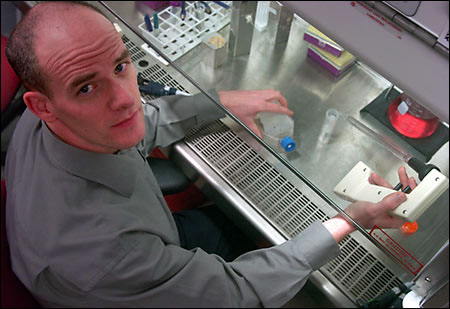Engineering with cells
Mooney seeks signals that provide cellular instructions

David Mooney is examining the body’s natural cellular functions in hopes of becoming a very good copycat.
An expert in tissue engineering, Mooney is striving to find ways to mimic natural signals to cells so that scientists and, ultimately, doctors can turn them on and off at will in order to grow new blood vessels, bone, or other needed tissues.
“I strongly believe the systems we’re developing will help us understand processes and lead to therapies in the future,” Mooney said.
How far in the future Mooney won’t guess, however, saying his work is currently being conducted in animal models and is years away from being developed into useful therapies for humans.
Mooney, who was named Gordon McKay Professor of Bioengineering in the Division of Engineering and Applied Sciences (DEAS) in July, said the ultimate goal of his field is to be able to regenerate all of the tissues and organs in the body by either instructing cells already present in or around a diseased or lost tissue, or by growing cells in the lab to form organs that could then be implanted into people whose own organs have failed.
Significant progress has already been made in this research area, as engineered skin and cartilage are currently used to treat patients, but researchers are still short of the goal of creating entire internal organs. Mooney’s work is helping advance the field and is fostering connections among experts in different disciplines who will need to work together to reach the field’s goal.
“David Mooney is a star in the growing field of tissue engineering,” said DEAS Dean Venkatesh Narayanamurti. “He brings DEAS new connections in biomaterials, biochemical engineering, and with the medical school and teaching hospitals. I am delighted he chose to accept our offer. He is beginning to make a significant impact on our community.”
Mooney’s current work focuses on designing materials that signal cells to go down certain developmental pathways, such as multiplying or differentiating into another kind of cell. By inducing blood vessels to grow, for example, blood supplies could be restored to tissues robbed of oxygen, such as heart muscle for those suffering coronary artery disease.
“We’re trying to understand the design of materials at the nanoscale,” Mooney said. “We’re trying to understand how the presentation of signals influences cell and tissue response.”
The materials designed in Mooney’s laboratories control cell signaling in a temporally and spatially dynamic manner, to more closely mimic nature. His research team is also looking at the connections between blood vessel formation and the formation of other types of tissues, such as bone and even tumors. He’s found that cells that form blood vessels influence stem cells for bone tissue, for example, and he is examining whether that signaling can be re-created artificially.
They’ve learned that the timing of a particular signal is as important as is the signal’s nature. As cells develop and grow, they require particular signals at particular times to send them down different pathways. If the correct sequence of signals isn’t available, the process will stall without forming a functional tissue. Learning how to re-create both the signals and the timing that occur during development may prove useful in inducing damaged adult tissues to regrow.
Mooney’s projects promoting blood vessel formation and bone growth are the furthest along. He’s begun collaborating with researchers at Harvard Medical School, the University of Michigan, and biotechnology companies to test these approaches in large animal models.
Mooney came to Harvard in July from the University of Michigan, where he served as assistant professor, associate professor, and professor in the Departments of Chemical Engineering, Biomedical Engineering, and Biologic and Materials Sciences. He is no stranger to the Boston area, however, having done his doctoral work at the Massachusetts Institute of Technology and having served as a postdoctoral fellow at Harvard Medical School.
Mooney said he’s always been interested in chemistry and math and studied chemical engineering at the University of Wisconsin during his undergraduate years. It was during a summer internship doing pharmaceutical development that he became interested in how drugs and other materials could be used to manipulate cells.




